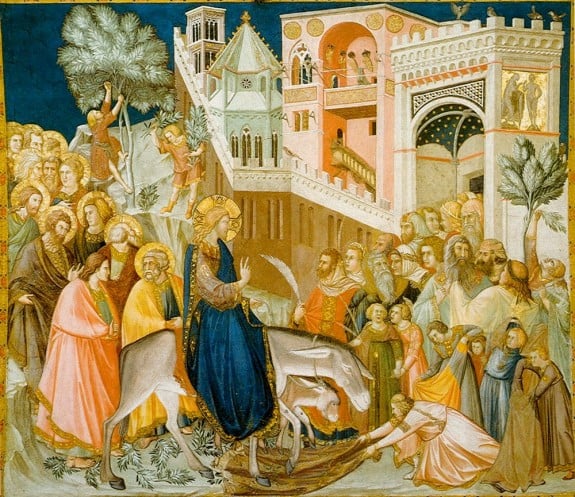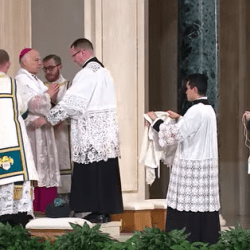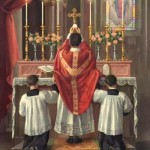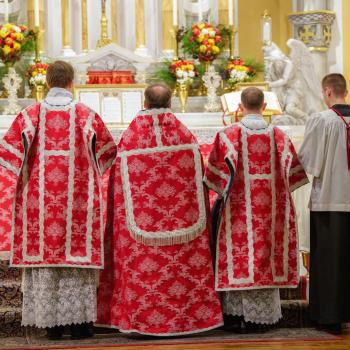This subject comes up periodically, and just today a friend on Facebook asked a question about where he could find the gospel for this weekend broken up into parts, for several people to proclaim.
It’s worth a look at a 1988 document, Paschalis Sollemnitatis, which gives guidance on how to proclaim the Passion:
33. The passion narrative occupies a special place. It should be sung or read in the traditional way, that is, by three persons who take the part of Christ, the narrator, and the people. The passion is proclaimed by deacons or priests, or by lay readers. In the latter case, the part of the Christ should be reserved to the priest.
The proclamation of the passion should be without candles and incense; the greeting and the sings of the cross are omitted; and only a deacon asks for the blessing, as he does before the Gospel. [37] For the spiritual good of the faithful, the passion should be proclaimed in its entirety, and the readings that proceed it should not be omitted.
The Adoremus article also notes:
The Newsletter of the US Bishops’ Committee on the Liturgy, Jan.-Feb. 1999, comments on the presentation of the Passion in parts, and makes this point:
While it has a dramatic quality, the Passion is not so much a drama enacted as a narrative proclaimed solemnly and simply, without candles, incense, greeting, or signs of the cross. (Original emphasis.)
The article urges that “careful consideration should be given to the effect which this practice may have” — does reading in parts mean that everyone in the congregation is watching the “script”? Does it “allow each individual to meditate effectively on the word proclaimed?” (Thirty-Five Years of the BCL Newsletter, USCCB, 2004, pp 1625-26.)
A few years ago, Mark F. Hoggard over at PrayTell made a case against reading the Passion in parts:
According to the GIRM, the ONLY reading that is allowed to be read in parts is the Passion (an exception to this rule is found in Masses with Children). That said, it is not required to be read in parts. The rubric for Passion Sunday (#21) states that “The narrative of the Lord’s Passion is read…by a Deacon or, if there is no Deacon, by a Priest. It may also be read by readers, with the part of Christ, if possible, reserved to a Priest.” The rubric for Good Friday (#9) simply states that “the narrative of the Lord’s Passion according to John…is read in the same way as on the preceding Sunday.”
A few things should be considered carefully when preparing the proclamation of the Passion:
- Although the Passion may be read in parts, it is by no means required.
- Nowhere in the rubrics is the practice of the assembly taking a part (e.g., the crowd) presented as an option (except for Directory of Masses with Children, #47). I would argue that this option would be less than desirable (though not forbidden), since the Lectionary for Mass: Introduction states the role of the faithful in the Liturgy of the Word clearly when it says that “The congregation of Christ’s faithful even today receives from God the word of his covenant through the faith that comes by hearing…the faithful at the celebration of Mass are to listen to the word of God with an and outward reverence…” (#45, emphasis added). Although attempts to “act out” the scriptures at Mass may be well-intentioned, I believe that it goes beyond the principle of proclamation.
- On a related note, I would also argue that the custom of the assembly being seated for the Passion (a posture that is nowhere even suggested in any of the rubrics) puts the assembly in a passive “audience” mode, and removes the active stance of standing which sets the Gospel apart.
All that said, the Passion of the Lord is a lengthy text, with many twists and turns, and several voices. The proclaimers of these most sacred scriptures — whether a deacon or a priest, or several readers — must be the very best, and be well-prepared and practiced (but, really, isn’t that true of every Sunday?
Personally, I’ve never not heard the Passion read in parts, including contributions from the congregation, on Palm Sunday and Good Friday. But I don’t get around much; I’ve always spent those days at my local parish.
But if you ever tune in to watch how it’s done at the Vatican, you’ll see it’s broken into just three parts—Narrator, Christ, Crowd—proclaimed by deacons.
Image from Wikipedia













